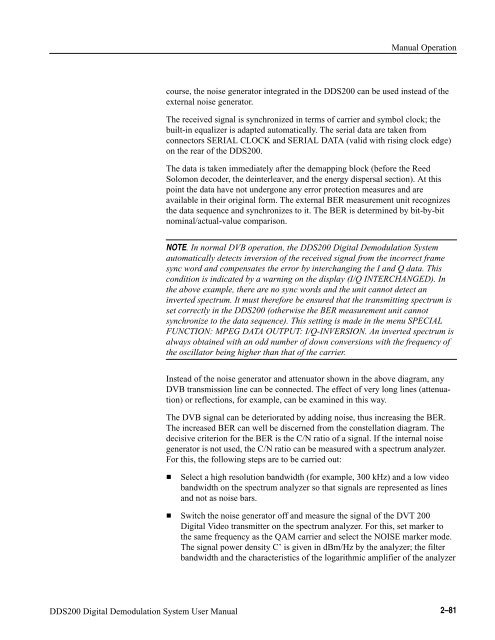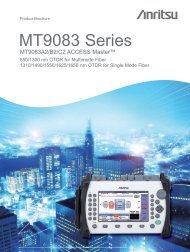User Manual DDS200 Digital Demodulation System 070-9952-00
User Manual DDS200 Digital Demodulation System 070-9952-00
User Manual DDS200 Digital Demodulation System 070-9952-00
Create successful ePaper yourself
Turn your PDF publications into a flip-book with our unique Google optimized e-Paper software.
<strong>Manual</strong> Operationcourse, the noise generator integrated in the <strong>DDS2<strong>00</strong></strong> can be used instead of theexternal noise generator.The received signal is synchronized in terms of carrier and symbol clock; thebuilt-in equalizer is adapted automatically. The serial data are taken fromconnectors SERIAL CLOCK and SERIAL DATA (valid with rising clock edge)on the rear of the <strong>DDS2<strong>00</strong></strong>.The data is taken immediately after the demapping block (before the ReedSolomon decoder, the deinterleaver, and the energy dispersal section). At thispoint the data have not undergone any error protection measures and areavailable in their original form. The external BER measurement unit recognizesthe data sequence and synchronizes to it. The BER is determined by bit-by-bitnominal/actual-value comparison.NOTE. In normal DVB operation, the <strong>DDS2<strong>00</strong></strong> <strong>Digital</strong> <strong>Demodulation</strong> <strong>System</strong>automatically detects inversion of the received signal from the incorrect framesync word and compensates the error by interchanging the I and Q data. Thiscondition is indicated by a warning on the display (I/Q INTERCHANGED). Inthe above example, there are no sync words and the unit cannot detect aninverted spectrum. It must therefore be ensured that the transmitting spectrum isset correctly in the <strong>DDS2<strong>00</strong></strong> (otherwise the BER measurement unit cannotsynchronize to the data sequence). This setting is made in the menu SPECIALFUNCTION: MPEG DATA OUTPUT: I/Q-INVERSION. An inverted spectrum isalways obtained with an odd number of down conversions with the frequency ofthe oscillator being higher than that of the carrier.Instead of the noise generator and attenuator shown in the above diagram, anyDVB transmission line can be connected. The effect of very long lines (attenuation)or reflections, for example, can be examined in this way.The DVB signal can be deteriorated by adding noise, thus increasing the BER.The increased BER can well be discerned from the constellation diagram. Thedecisive criterion for the BER is the C/N ratio of a signal. If the internal noisegenerator is not used, the C/N ratio can be measured with a spectrum analyzer.For this, the following steps are to be carried out:Select a high resolution bandwidth (for example, 3<strong>00</strong> kHz) and a low videobandwidth on the spectrum analyzer so that signals are represented as linesand not as noise bars. Switch the noise generator off and measure the signal of the DVT 2<strong>00</strong><strong>Digital</strong> Video transmitter on the spectrum analyzer. For this, set marker tothe same frequency as the QAM carrier and select the NOISE marker mode.The signal power density C’ is given in dBm/Hz by the analyzer; the filterbandwidth and the characteristics of the logarithmic amplifier of the analyzer<strong>DDS2<strong>00</strong></strong> <strong>Digital</strong> <strong>Demodulation</strong> <strong>System</strong> <strong>User</strong> <strong>Manual</strong> 2–81
















